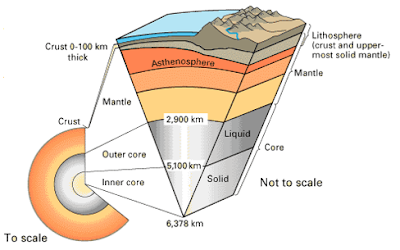Gravity settling or gravity differentiation is a key
geological process which can be easily demonstrated. Understanding the process helps explain
sedimentary structures, determine the way up of rocks and
explain planetary geology. The principle is not complicated. In a fluid,
heavier material will sink to the bottom faster than lighter material (provided
it has not been designed for fluid resistance, like a boat).
A video demonstrating how to show gravity settling can be
viewed here.
The principle of gravity settling is particularly relevant
in sedimentary rock formation, where sediment is commonly transported by wind
or water. As a river loses energy it will deposit its heaviest load first and
the finer sediment will be transported further downstream, until the river can
no longer carry it. The finest particles, like clay, will remain suspended for
the longest time and can be carried vast distances. By studying the sediment
size in fluvial rocks geologists can get an idea of the transport history of
the sediment and how far the rock formed from the source. Fluctuations in the
sediment sizes in the beds adjacent can indicate changes in the river energy, for
example, a flooding event or seasonal changes.
Order of
deposition diagram. The further from the river source the smaller the sediments
will be. (twinkl,
accessed 15/7/2020)
- This WASP activity demonstrates sorting by movement.
Graded bedding is a sedimentary structure which can indicate
the way up of a rock – with the coarser sediments found at the bottom of the
bed and a fining up sequence. This type
of sedimentary structure is often associated with turbidity currents. Turbidity
currents originate on the slope between the continental shelf and deep-sea
basin, where unstable sediment will start to build up. An event, such as an earthquake, will cause
sudden slope failure creating a submarine landslide, establishing a turbid
(murky) layer of water. When this turbid layer reaches the flatter deep sea
plain the current loses energy quickly and decelerates, making it drop the
sediments it was carrying (heaviest first, note: very occasionally conditions result in different bedding orders). This sedimentary structure can be
very useful to geologists as it can indicate if the beds have been flipped over
during folding as well as giving information about the deposition environment.
Sudden slope
failure can cause turbidity currents. (NOAA, accessed
15/7/2020)
Graded bedding
indicating the way up of a rock with heavy sediment settling first. (Wikimedia Commons, accessed 15/7/2020)
- This WASP activity allows students to make their own graded bedding.
Gravity differentiation is also particularly important for
planetary geology and understanding Earth’s formation. During the Hadean era (the first 0.6 billion
years of Earth’s history) the Earth was hot and molten. The material making up
the Earth was thus able to move. Heavier material, such as iron and nickel,
sunk to the centre of the Earth leaving a silicate rich crust, through density
sorting. Planetary differentiation due to gravity is common on all planetary bodies
and is known as the Great Iron Catastrophe (GIC) on Earth. The term catastrophe
here is used in the mathematical sense of the word “a large or sudden change”
rather than meaning “disaster”. We know the Earth must have a denser core than surface, as the
mass of the Earth is too great to be made only of silicate rich material, which
is what we find at the surface. Our knowledge of the interior of the Earth
comes primarily from earthquake data and research on meteorites.
|
Layer
|
Density
(g/cm 3)
|
|
Crust
|
2.2
|
|
Upper
Mantle
|
2.9
|
|
Lower
Mantle
|
3.4 –
4.4
|
|
Outer
Core
|
12.2
|
|
Inner
Core
|
13.1
|
Table showing the
average density of Earth’s layers – the layers become more dense with
depth.
The internal structure of the Earth. (Wikimedia Commons, accessed 15/7/2020)
- Here are some WASP activities relating to planetary differentiation.





